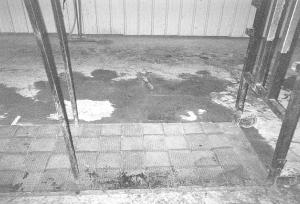Mats Made From Baler Belts Improve Footing
 ✖  |
While touring a feedlot in Nebraska in the summer of 1999, Justin Reiter noticed they were using rubber mats around the chute where they worked cattle. He says the mats were made from tire treads that were cut into long strips and then woven together. They also provided better footing for both workers and cattle.
"I decided I'd try to make some mats myself but getting the tread off the tires was difficult," he says.
Then Reiter, a Cascade, Iowa, high school senior and the son of Jacob and Beverly Reiter, found some used belts from a Deere 566 round baler in their machine shed. "These belts are 8 in. wide and more than 40 ft. long," he says. "I figured we could make mats out of those."
With help from his brother, Stan, Justin cut the old belts into shorter strips measuring 8 ft. and 3 ft. and wove these together into an 8-ft. by 3-ft. mat. They punched holes in the ends of the belts with a 1/4-in. drill bit and fastened them together with zip-tightening cable ties.
The two boys worked only about an hour to make their first mat. The cable ties, which cost about $5, were the only out-of-pocket expense.
"I used the mat in the blocking chute for my show steers," he says. "When you wash them, everything around gets wet. The mat keeps the animals from slipping on the wet floor. "
Reiter is making another mat that will be 12 ft. square to go in front of the chute used to treat feeder cattle for his family's feedlot. He thinks there might be a market for the baler belt mats, although he's not sure how much they might be worth. "I'm looking for more used baler belts so I can make more mats," he says.
Contact: FARM SHOW Followup, Justin Reiter, 23347 Bowens Prairie Road, Monticello, Iowa 52310 (ph 319 465-4149).

Click here to download page story appeared in.
Click here to read entire issue
Mats Made From Baler Belts Improve Footing BALE HANDLING Bale Handling (31B) 24-6-7 While touring a feedlot in Nebraska in the summer of 1999, Justin Reiter noticed they were using rubber mats around the chute where they worked cattle. He says the mats were made from tire treads that were cut into long strips and then woven together. They also provided better footing for both workers and cattle.
"I decided I'd try to make some mats myself but getting the tread off the tires was difficult," he says.
Then Reiter, a Cascade, Iowa, high school senior and the son of Jacob and Beverly Reiter, found some used belts from a Deere 566 round baler in their machine shed. "These belts are 8 in. wide and more than 40 ft. long," he says. "I figured we could make mats out of those."
With help from his brother, Stan, Justin cut the old belts into shorter strips measuring 8 ft. and 3 ft. and wove these together into an 8-ft. by 3-ft. mat. They punched holes in the ends of the belts with a 1/4-in. drill bit and fastened them together with zip-tightening cable ties.
The two boys worked only about an hour to make their first mat. The cable ties, which cost about $5, were the only out-of-pocket expense.
"I used the mat in the blocking chute for my show steers," he says. "When you wash them, everything around gets wet. The mat keeps the animals from slipping on the wet floor. "
Reiter is making another mat that will be 12 ft. square to go in front of the chute used to treat feeder cattle for his family's feedlot. He thinks there might be a market for the baler belt mats, although he's not sure how much they might be worth. "I'm looking for more used baler belts so I can make more mats," he says.
Contact: FARM SHOW Followup, Justin Reiter, 23347 Bowens Prairie Road, Monticello, Iowa 52310 (ph 319 465-4149).
To read the rest of this story, download this issue below or click
here to register with your account number.







